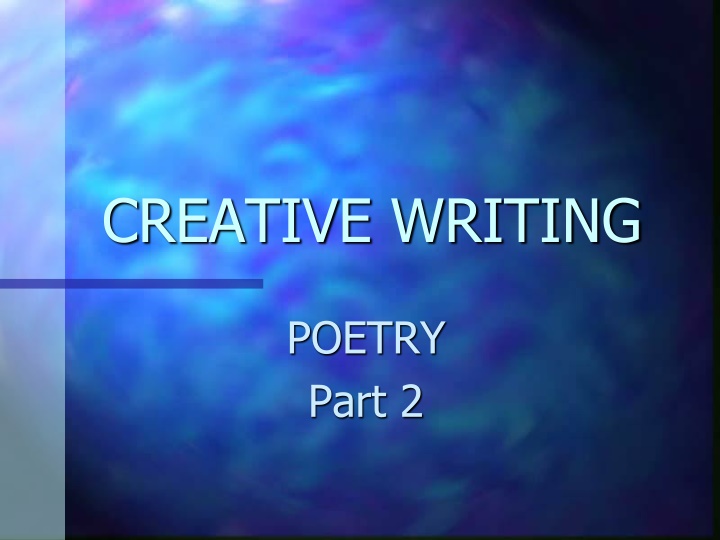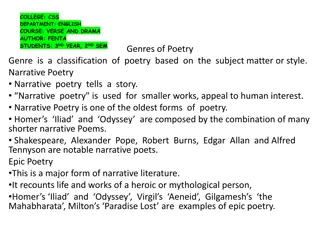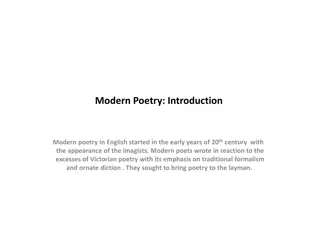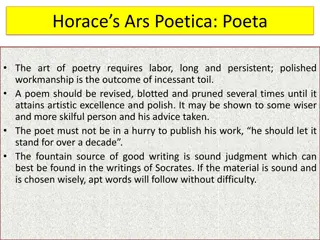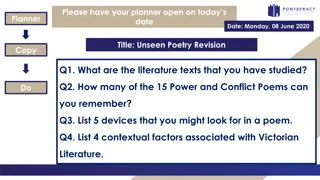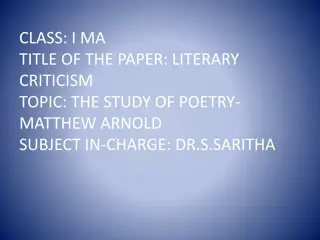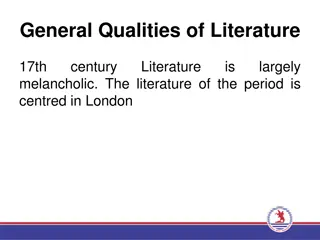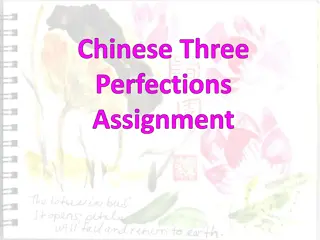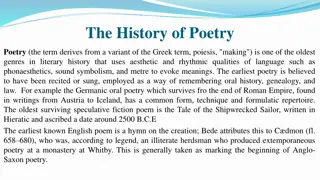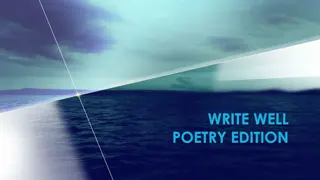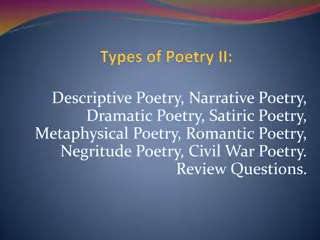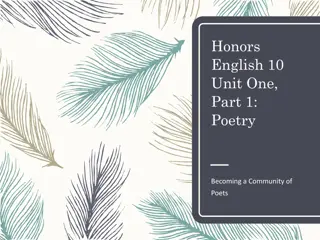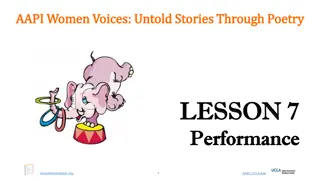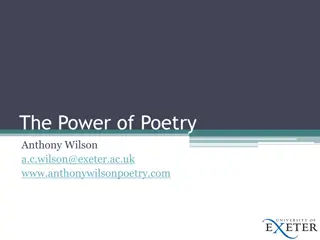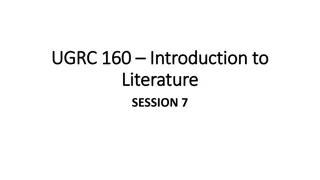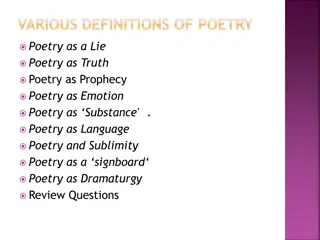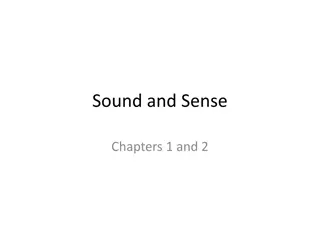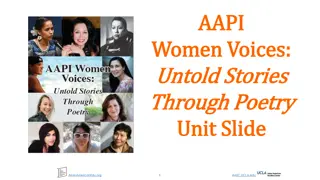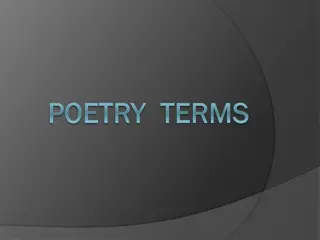Different Types of Poetry
Delve into the world of poetry with acrostic, cinquain, haiku, lyric, riddle, and shape poems. Learn how each form uniquely expresses emotions through words and structure. Discover the beauty of crafting verses that evoke imagery, emotions, and thought-provoking riddles.
Download Presentation

Please find below an Image/Link to download the presentation.
The content on the website is provided AS IS for your information and personal use only. It may not be sold, licensed, or shared on other websites without obtaining consent from the author.If you encounter any issues during the download, it is possible that the publisher has removed the file from their server.
You are allowed to download the files provided on this website for personal or commercial use, subject to the condition that they are used lawfully. All files are the property of their respective owners.
The content on the website is provided AS IS for your information and personal use only. It may not be sold, licensed, or shared on other websites without obtaining consent from the author.
E N D
Presentation Transcript
CREATIVE WRITING POETRY Part 2
ACROSTIC - a type of poetry where the first, last or other letters in a line spell out a particular word Example An acrostic poem using the beginning of lines Example - An acrostic poem using the end of lines
Cinquain - a verse of five lines that do not rhyme. Example My mum (2 syllables) Is so caring (4 syllables) She is always helpful (6 syllables) She is so beautiful and kind (8 syllables) Love you. (2 syllables) A cinquain consists of five unrhymed lines. Each line has a set number of syllables see below: Line 1: 2 syllables Line 2: 4 syllables Line 3: 6 syllables Line 4: 8 syllables Line 5: 2 syllables
Haiku - a Japanese poem Example consists of 3 lines and 17 syllables. Each line has a set number of syllables see below: (5) The sky is so blue. (7) The sun is so warm up high. (5) I love the summer. Line 1 5 syllables Line 2 7 syllables Line 3 5 syllables
Lyric No, there are no regrets since you walked my way No, there are no regrets since we met that day Those cheesy walks along the beach still fill my mind Those cheesy lines you always managed to find Only you could get away with such things But happiness and joy you seemed to bring A holiday in the sun went by in a dream Moving in seemed the logical thing A Lyric is a poem that expresses personal and emotional feelings. An example of a Lyric poem No, there are no regrets since you walked my way No, there are no regrets since we met that day
Riddle describes something w/o actually naming it. Example Example I come in different styles I can help you walk for miles I come in a pair I m something you wear With heels I am glam Can you guess what I am ? Shoes. It is an animal It is orange and black It has stripes It has four paws It lives in the jungle What is it? A tiger.
Shape Poem - a type of poetry that describes an object and is shaped the same as the object the poem is describing. Example - A volcano. a huge rock, shooting lava up into the air! Everyone runs for cover. Lots of thick, black smoke pours out of the top, giving you a warning before the explosions start. Nothing can stand in its way. Sometimes they don t blow up for hundreds of years. Still thousands in the world but they don t all work, some are even underwater.
Tanka - a Japanese poem similar to a haiku but has two additional lines. Consists of 5 lines and 31 syllables. Example (5) I love my kitten. (7) She is so little and cute. (5) She has a pink tongue, (7) And lots of long whiskers too. (7) She purrs when I stroke her back. Each line has a set number of syllables see below: Line 1 5 syllables Line 2 7 syllables Line 3 5 syllables Line 4 7 syllables Line 5 7 syllables
Tybur - a six line poetic form Example The first four lines consist of just a single two syllabled word each that all rhyme. The last two lines are nine syllables where the fifth to eighth syllables are the words from the first four lines. Crashing Clashing Splashing Thrashing Crashing, clashing sea Swims a little splashing, thrashing me.
Diamante - written in the shape of a diamond. Example Made up of 7 lines using a set structure: Bike Shiny, quiet, Line 1: Beginning subject Line 2: Two describing words about line 1 Line 3: Three doing words about line 1 Line 4: A short phrase about line 1, a short phrase about line 7 Line 5: Three doing words about line 7 Line 6: Two describing words about line 7 Line 7: End subject Pedaling, spinning, weaving Whizzing round corners, zooming along roads Racing, roaring, speeding Fast, loud, Car
Kenning - a two word phrase describing an object often using a metaphor. A Kennings poem is a riddle made up of several lines of kennings to describe something or someone. My Sister Dummy-sucker Teddy-thrower Anything-chewer A riddle made up of several lines of kennings to describe something or someone. Consists of several stanzas of two describing words. It can be made up of any number of Kennings. Kiss-giver Slave-employer Dolly-hugger Calm-destroyer Milk-drinker Nappy-leaker Peace-breaker Scream-shrieker Unlike any other My sister
Pantoum - a verse form consisting of three stanzas. It has a set pattern within the poem of repetitive lines. Riverside (1) As I walk by the riverside (2) Ripples disturb the water (3) Fish dart upstream (4) Fighting against the flow The pattern in each stanza is where the second and fourth line of each verse is repeated as the first and third of the next. The pattern changes though for the last stanza to the first and third line are the second and fourth of the stanza above (penultimate). The last line is a repeat of the first starting line of the poem and the third line of the first is the second of the last. (2) Ripples disturb the water (5) Struggling to their destination (4) Fighting against the flow (6) In their underwater world (5) Struggling to their destination (3) Fish dart upstream (6) Through the fields and vales and valleys they glide (1) As I walk by the riverside
